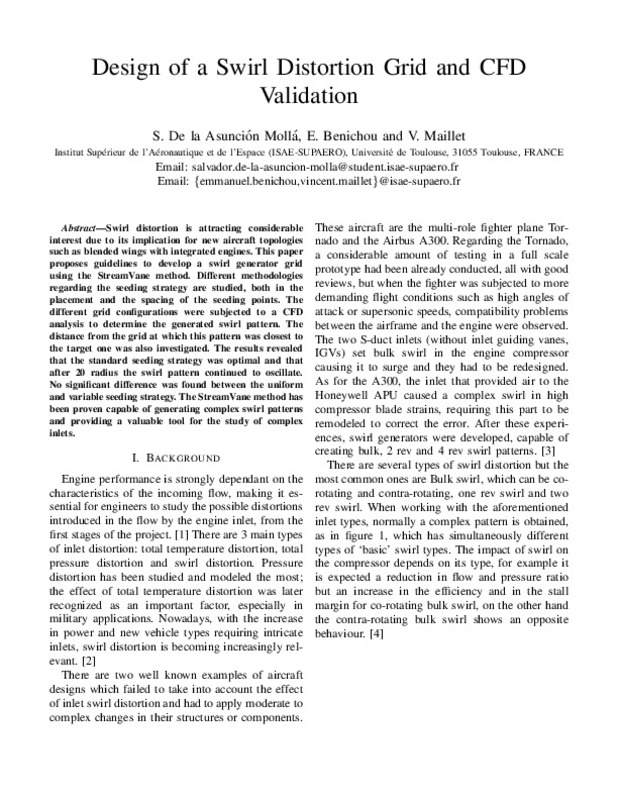|
Resumen:
|
[ES] El rendimiento de los motores a reacción se ve muy afectado por las irregularidades del flujo de aire que entra en ellos. La distorsión de tipo swirl en el flujo será estudiada en este trabajo, y como simularla. ...[+]
[ES] El rendimiento de los motores a reacción se ve muy afectado por las irregularidades del flujo de aire que entra en ellos. La distorsión de tipo swirl en el flujo será estudiada en este trabajo, y como simularla. El objetivo del estudio es usar el método de diseño StreamVane, ideado por Kevin M.Hoopes, y optimizar sus parámetros de
entrada para reproducir lo mejor posible el patrón de distorsión. En mi trabajo, el patrón de entrada de swirl será entregado por el departamento DAEP en ISAE-SUPAERO, este ha sido generado mediante una simulación de un turbofán integrado en un ala. A diferencia de los patrones de distorsión estudiados por Hoopes, que eran bastante
simples y no representaban los problemas de hoy en día (swirl de tipo bulk y dobles vórtices), el patrón entregado por el DAEP será mucho mas complejo y por lo tanto nos podremos preguntar si el método de StreamVane puede ser usado en estos casos satisfactoriamente.El proyecto tendrá dos etapas principales; una de diseño de las rejillas en Matlab, seguida de una etapa de simulación CFD usando STARCCM+. En la etapa de diseño, una versión modificada del código de Matlab de Hoopes será usada y nuevas estrategias de sembrado de puntos (entre otras) serán estudiadas para obtener un diseño de la rejilla que cubra toda la vena de ensayo. El código será modificado para que cree bastantes rejillas modificando entre ellas parámetros clave y él mismo las clasificará según su calidad, de esta manera se puede trabajar con grandes números de rejillas a la vez. Después de conseguir 4 rejillas con configuraciones diferentes, los diseños serán importados a STARCCM+ (via CATIA) y una simulación 3D será ejecutada para verificar si finalmente las rejillas son capaces de simular el patrón original de swirl. La distancia aguas abajo desde la rejilla en la que mejor se reproduce el patrón también será estudiado (3 radios, 4 radios, etc).
[-]
[EN] The performance of jet engines is greatly affected by the non-uniformities of the airflow entering them. Swirl distortion in the flow will be studied in this work, and how to simulate it. The
objective of the ...[+]
[EN] The performance of jet engines is greatly affected by the non-uniformities of the airflow entering them. Swirl distortion in the flow will be studied in this work, and how to simulate it. The
objective of the study is to use the StreamVane design method, by Kevin M.Hoopes, and optimize its input parameters in order to reproduce as best as possible the desired swirl pattern. In my work, the input swirl pattern is given by the DAEP department in ISAE-SUPAERO after performing a simulation of a turbofan engine integrated in the wing. The swirl patterns studied by Hoopes are quite simple and not representative of real life problems (bulk swirl and twin vortex swirl), the DAEP pattern will be much more complex and therefore the question of whether the StreamVane method will or will not be able of reproducing it satisfactorily is posed.The project will have two main stages; a design stage of the grids in Matlab, followed by a simulation stage in CFD using STARCCM+. In the design stage, a modified Matlab code of the Hoopes work will be used and new seeding strategies (among others) will be studied in order to get a grid design that covers all of the vane. The code will be modified to create many grids varying key parameters and it will itself classify the grids quality by a parameter that captures the `fillness¿ of the vane, making it possible for the program to work with a great number of grids. After 4 different configurations of the grids have been obtained, the designs will be imported to STARCCM+ (via CATIA) and a 3D simulation will be performed to verify if the grids are indeed reproducing the original swirl pattern. The distance downstream from the grid which best recreates the swirl pattern will also be studied (ex. 3 radius, 4 radius, etc).
[-]
|







